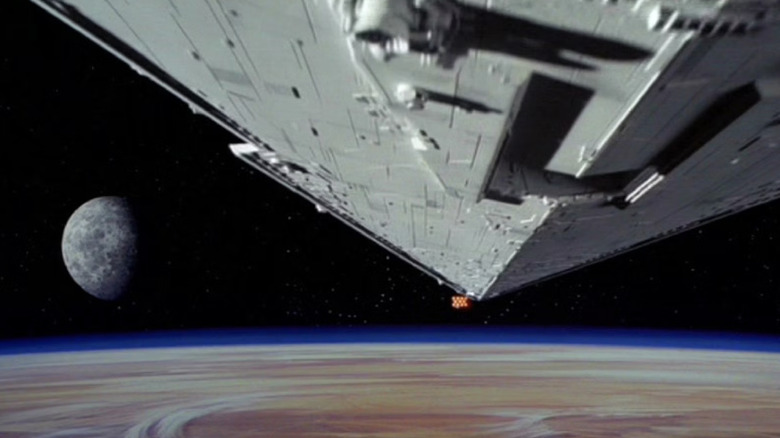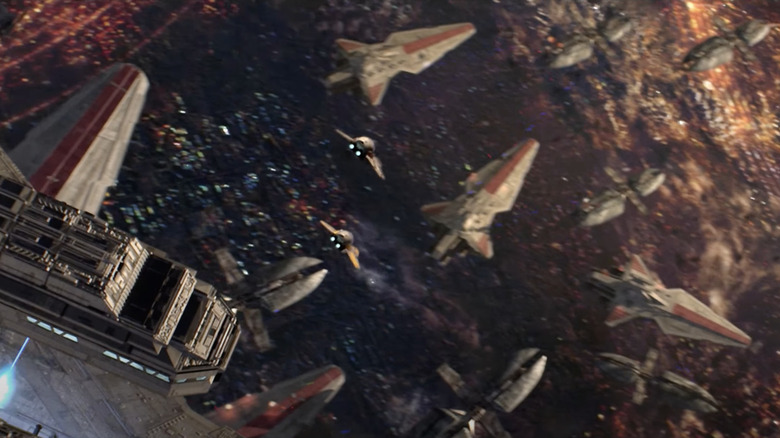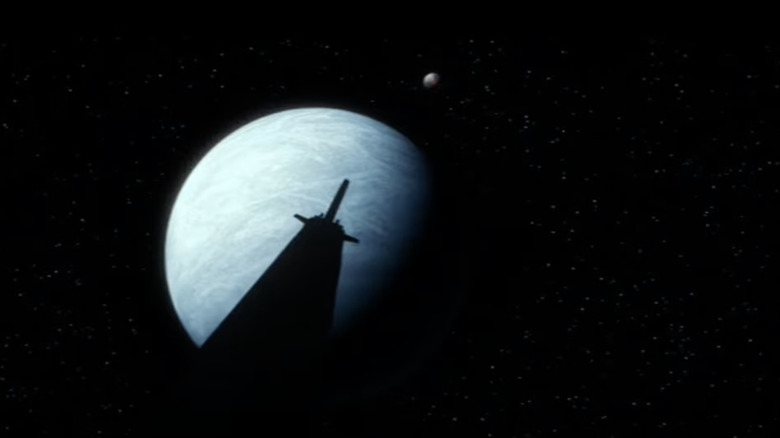How Star Wars Created The Original Opening Crawl Using Black Paper
Every "Star Wars" movie in the main, nine-part "Skywalker Saga" opens the same way: "A long time ago, in a galaxy far, far away..." silently beckons us to adventure, the trumpets of John Williams' theme blast, the static blue text recedes from the screen into a starry black sky, and a scroll of golden text sets where in media res the story is. This text crawl recap is just one of the many flourishes "Star Wars" creator George Lucas added to make the films feel like the serials of his youth.
Crafting the opening crawl was a team effort, involving everyone from title designer Dan Perri — I spoke with him about designing the "Star Wars" logo — to visual effects second cameraman Dennis Muren. The latter spoke about that experience for a DVD commentary, recorded in 2004 for the original "Star Wars" trilogy's DVD box set release. Muren spoke alongside Lucas, Princess Leia herself Carrie Fisher, and sound designer Ben Burtt.
Muren is the last of the four to introduce himself, but he gets an early opening to speak. After Lucas explains why the original release of "Star Wars" wasn't titled "Episode IV: A New Hope" (executives were worried about confusing the audience), Muren recounts filming the opening crawl as it plays before him and, presumably, you the viewer.
Filming a model
Dennis Muren reminds the listener that "Star Wars" was made in the era before computer-generated effects: "Back before 1990, almost everything was done with physical models, we'd build models, set them up in front of the cameras, put lights on them." Thus, to make the crawl, they had to make a physical model — according to Muren, it was a piece of black paper, "about two feet wide and six feet long," with letters printed on it.
The model was placed beneath a motor-run camera that ran down along it, to create the illusion of the letters progressing up the screen. Muren explained, "[The camera] ran at a very slow speed but it allowed pretty fast motions when you played the film back at normal speed."
Dan Perri got the idea of the letters coming up the screen from the title sequence of the 1939 Western film "Union Pacific" — in that film, the letters scrawl across the screen like a train moving along a rail track. However, as Perri told Art of the Title, there were plenty of other things to consider about the crawl's presentation — he had to perfect his design for the film's logo to account for shooting specifications and a more complicated design like the crawl was no different. Perri listed some questions the team had to ask themselves:
"How big would the type be? What angle would it be at? When it came in, how fast would it move? I played with the idea of it moving at different speeds, slower and faster. Since the legend was talking about things that were important to the viewers to know about the story, you had to be able to read that for as long as possible."
Getting to perfection
This resulted in "hours and hours and days and days" of tests to get the speed and perspective of the crawl just right. The original "Star Wars" crawl crew also tried out different colors, including orange, blue, and white, before settling on gold for the letters. Dennis Muren says that the original version of the crawl took "forever" to shoot: "It probably took like 3 hours, we had to shoot 2–3 versions of it. There [were] also a lot of different language versions of it and all."
Muren wound up staying with "Star Wars" for decades. He not only worked on the next two films, "The Empire Strikes Back" and "Return of the Jedi," but also the Special Editions of the original trilogy, the middle chapter of the prequel trilogy "Attack of the Clones," and finally the opening entry of the sequel trilogy "The Force Awakens."
In the latter two "Star Wars" trilogies, the crawls were all created digitally, saving the crews of those films a lot of time. Later iterations of the crawl, though, couldn't have been done without the experimentation and perfected result by Dan Perri, Dennis Muren, and the rest of the effects crew on the original "Star Wars". And to think that filmmaking experimentation all started with a six-foot strip of black paper.


